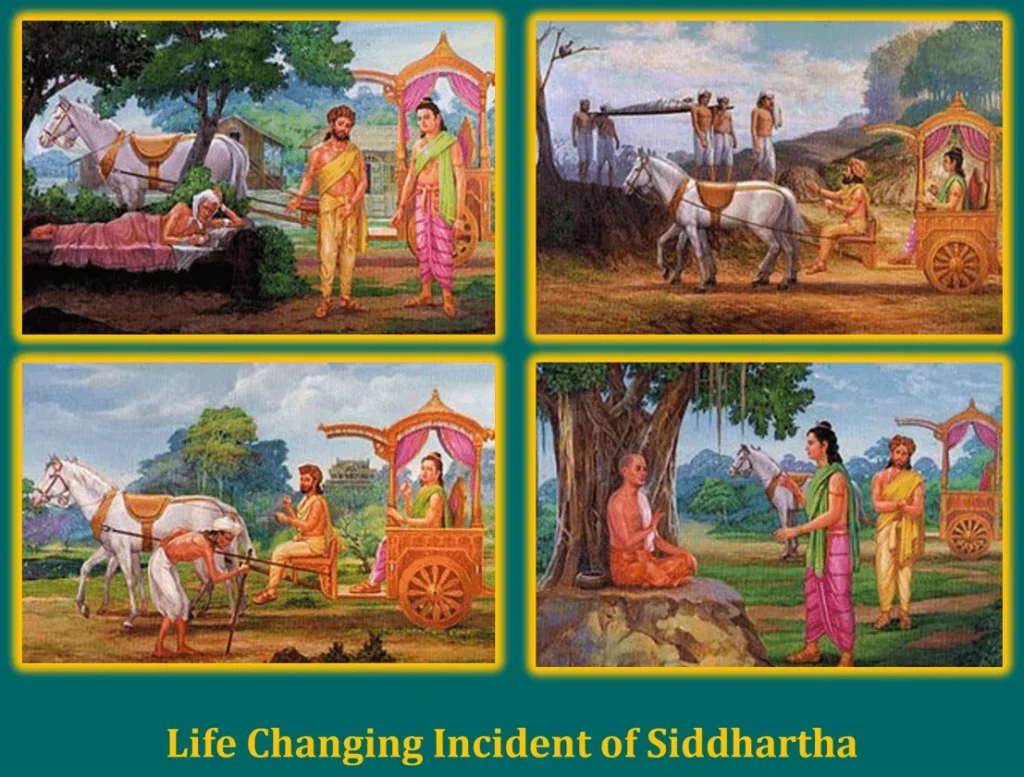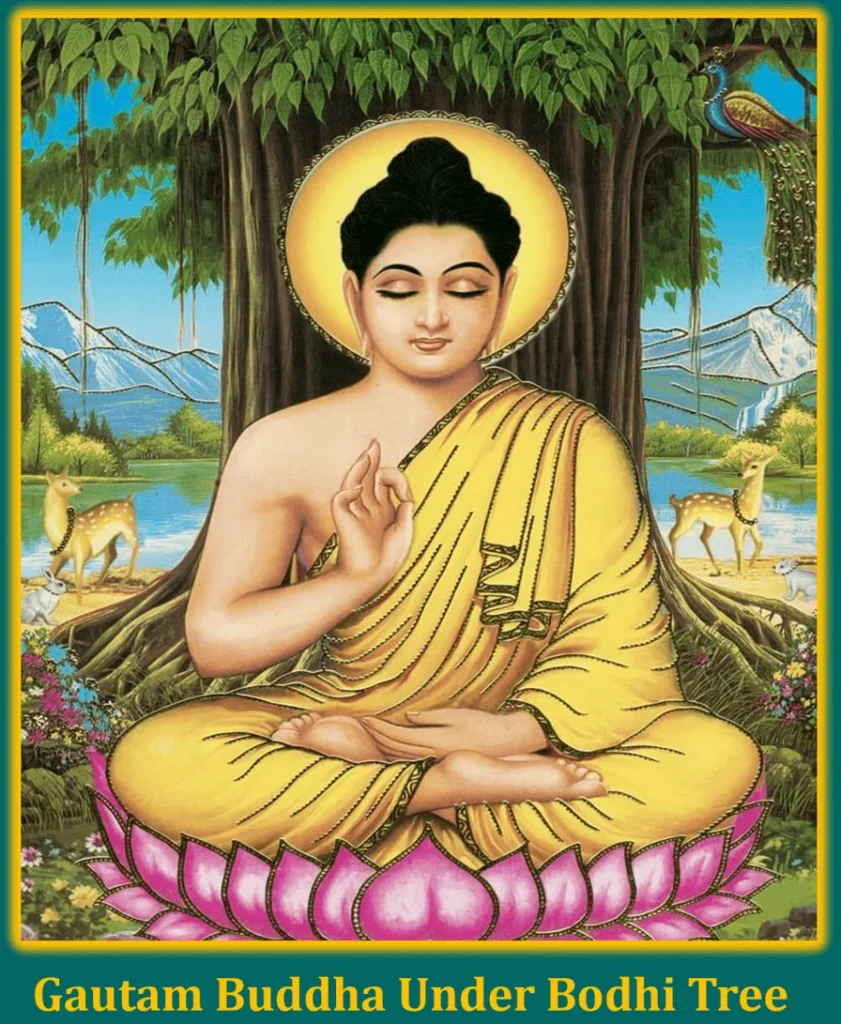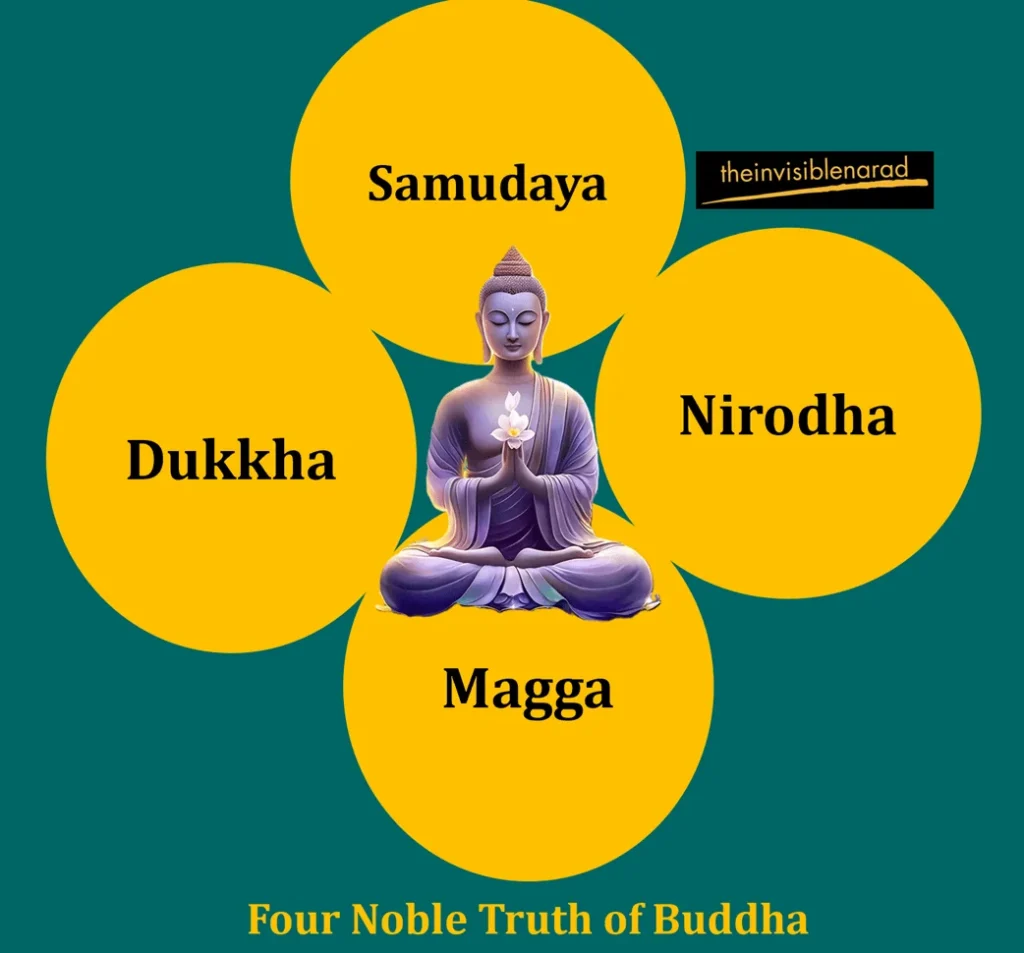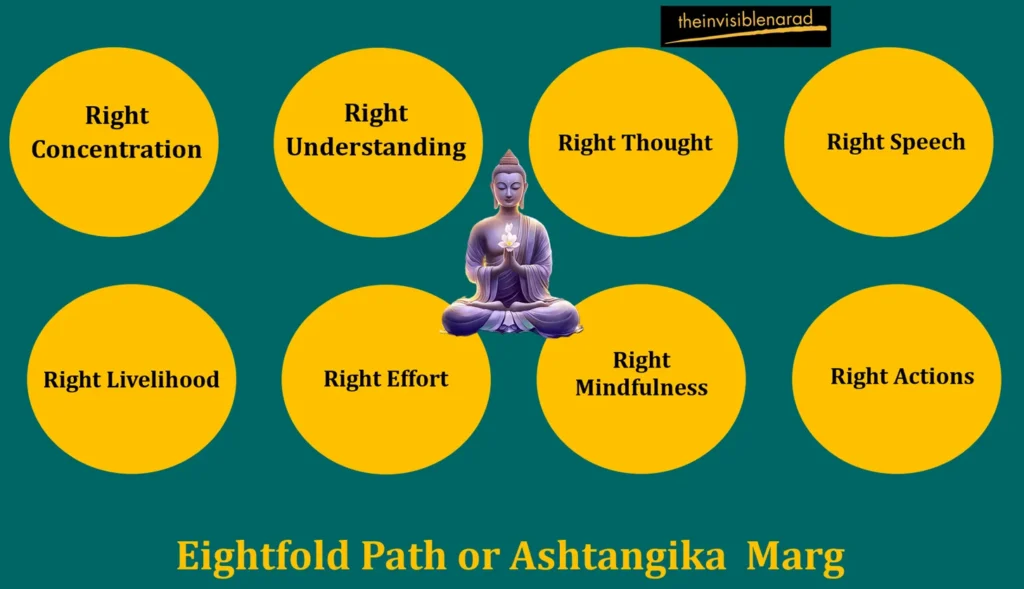
Introduction
Gautam Buddha was historical character who set out on a quest for enlightenment. His childhood name was Siddhartha. Today his ideas and teachings continue to impact millions of people. In this blog article we will explore the significance of Gautam Buddhas life and origins.
Birth and Early Childhood
Gautam Buddha, who is also considered the incarnation of Vishnu by Hindus was born in Lumbini near Kapilvastu on Vaishakha Purnima in 563 BC. Siddhartha’s father, Suddhodana ruled over the Shakya Clan with Kapilvastu as their capital city. Sadly, his mother Queen Maya passed away after his birth. He was then raised by his aunt Gautami. Came to be known as Gautam due to her care and guidance. Although born into royalty with a life of luxury and privilege Siddhartha’s destiny took a turn when a sage prophesied that he would become a sage himself.
Consequently, Siddhartha’s life became confined within the palace walls under the provisions provided by his father. As a prince he experienced opulence and comfort shielded from the realities, beyond the palace borders. However, despite having every desire fulfilled for him Siddhartha developed a sense of dissatisfaction and curiosity within him.
Early Marriage and his Married Life
At the tender age of 16, Prince Siddhartha entered the bond of matrimony with Princess Yasodhara, his cousin and the daughter of Sakya Chieftain Suprabuddha. Their union brought forth the arrival of a son named Rahul. Siddhartha’s early years were spent in the comfort of a marriage shielding him from the realities of the outside world. Did he know, the true extent of suffering remained distant and hidden behind the walls of his sheltered existence.
Encounters with Suffering and the Four Sights
It was a turning point, in Gautam Buddhas life when he made the decision to step beyond the confines of his palace. Exploring the city, he came across four sights that forever changed his perspective. He witnessed a person someone afflicted with illness, a body and finally an ascetic. These encounters exposed him to the nature of suffering, old age and death.

These experiences marked Gautam Buddhas journey towards enlightenment as he recognized the impermanence and fragility of life. Motivated by a desire to find a solution for suffering he chose to renounce his lifestyle and embarked on a spiritual quest.
Gautam Buddhas teachings quickly gained popularity. Attracted followers who sought solace and enlightenment. His profound wisdom and unique approach to life resonated with individuals, from all walks of society challenging established hierarchies and inspiring many.
An Incidence reflecting Siddhartha Kindness
In the enchanting embrace of a spring dawn, Siddhartha reveled in playful moments by the river winding through the palace gardens. The ethereal sight of swans, adorned with feathers kissed by the golden rays of the morning sun, captured his attention. Mesmerized, Siddhartha paused to admire their graceful dance upon the glistening waters. “Oh, you’re enchanting,” he murmured to the elegant swans, finding a serene spot by the riverbank to witness their ballet.
Amidst this idyllic scene, a sudden disruption shattered the tranquility—an arrow, swift and purposeful, emerged from the air, finding its mark in the largest and most majestic of the swans. A gasp escaped Siddhartha as he sprinted toward the wounded creature. The swan, now writhing in agony, struggled helplessly, its once-majestic wings compromised by the cruel arrow.
With compassion blazing in his eyes, Siddhartha extended his hands to the injured swan, coaxing it with soothing words. Cradling the creature gently, he waded through the river, determined to mend the harm inflicted upon this symbol of beauty and grace. As Siddhartha carefully extracted the arrow, fashioning a makeshift splint from a nearby stick and a bandage from a torn strip of his garment, the swan’s fate hung in the balance.

Meanwhile, Devadatta, the archer of the ill-fated arrow, arrived in pursuit of his lost projectile. A witness to the unfolding drama, he laid claim to the wounded swan. “That swan is mine—I shot it, not you,” asserted Devadatta.
Contrary to Devadatta’s assertion, Siddhartha, resolute in his empathy, proclaimed, “No, it belongs to me. I saved it.”
The dispute reached the ears of their guru, who contemplated the conflicting tales. Turning to Siddhartha, the teacher posed the pivotal question, “Well, Siddhartha, what do you have to say?”
“Devadatta injured the swan without cause. It was simply basking in the river’s embrace, radiating beauty. Why did he shoot it? I won’t let him harm it again. I healed it—it is now mine,” Siddhartha declared with unwavering conviction.
A benevolent smile graced the guru’s countenance upon hearing Siddhartha’s words. “The swan belongs to Siddhartha,” the wise teacher proclaimed. “Siddhartha has not only saved its life but also tended to its wounds. Devadatta, in his pursuit of destruction, cannot claim ownership. No one can possess a living being except the one who nurtures it with love. Thus, the swan remains with Siddhartha.”
Significance of Gautam Buddha in History
The teachings and philosophy of Gautam Buddha have left an impact, on the course of history. His message, which emphasized compassion, non violence and mindfulness deeply resonated with individuals from backgrounds. The principles of the Four Truths and the Eightfold Path, in Buddhism offer guidance for surpassing suffering and attaining true enlightenment. Today Gautam Buddhas teachings have an impact, on the lives of numerous individuals worldwide. His emphasis, on peace, mindfulness and compassion strikes a chord with individuals who seek solace amidst the tumultuousness and anguish that often surrounds us.
“The mind is everything. What you think, you become.”
– Gautam Buddha
The Great Renunciation
Siddhartha’s decision to give up his luxurious lifestyle
The above-mentioned experiences of the four man totally changed the mindset of Siddhartha. He was only 29 when he decided to know the truth of life. This profound realization led him to let go of his status, family, wealth and material possessions. He left his sleeping wife and son and went out for enlightenment. It was this act of renunciation that marked the beginning of his quest, for self-discovery and spiritual enlightenment.

The quest for truth through asceticism
Siddhartha embarked on a pursuit for truth and understanding. He sought guidance from practitioners and fully embraced a life of extreme asceticism. Under the guidance of Alarakalam he learned meditation techniques to delve deeper within himself. Through fasting and austere practices Siddhartha explored philosophies and meditation methods in hopes of finding liberation from suffering. However, he soon realized that excessive self-mortification was not the path, to enlightenment. This realization led him to adopt a Middle Way approach that emphasized finding balance and moderation.
The Awakening beneath the Sacred Bodhi Tree
After devoting himself to discipline for years Siddhartha Gautama experienced a profound realization that would forever alter his existence. He discovered a spot to a peepal tree now famously known as the Bodhi Tree situated by the Niranjana River in Bodh Gaya. In his meditation Siddhartha confronted struggles, battling distractions, doubts and temptations. Eventually after six years of meditation on the night of Vesak (Vesak Purnima) during a moon he attained enlightenment. This marked Siddhartha Gautama’s transcendence, from the cycle of birth and death and his awakening to enlightenment. Consequently, he came to be revered as Buddha (Gautam Buddha) signifying the one who had awakened.

Teachings of Gautam Buddha
The Four Noble Truths
The four noble truth taught by Buddha are as follows:

- Understanding suffering (Dukkha): Buddha believed that suffering is a part of being human. Whether its pain or emotional distress everyone experiences suffering. Acknowledging and accepting the reality of suffering is the step towards its resolution.
- Origin of suffering (Samudaya): According to Buddha, desire, attachment and ignorance were the root cause of suffering in any human life. Our desires and attachments lead to dissatisfaction and a continuous longing creating a cycle of anguish. Breaking free from these attachments is essential for discovering lasting peace and satisfaction.
- Cessation of suffering (Nirodha): The third noble truth explores the possibility of ending suffering. It asserts that through eliminating craving, attachment and ignorance one can achieve liberation, from the clutches of suffering and attain happiness.
- The way to end suffering (Magga): The Fourth Noble Truth describes the Eightfold Path or Ashtangika Marg, which acts as a guide, towards ending suffering and achieving enlightenment. This path covers aspects of behavior mental growth and wisdom.
Ashtangika Marg or The Eightfold Path
The path known as the Eightfold Path or the Middle Way provides a framework, for living a virtuous life.

- Right Understanding: Having an Understanding entails perceiving reality as it truly is, acknowledging the impermanent nature of things and comprehending how everything is interconnected. This understanding serves as the basis for growth and liberation.
- Right Thought: Cultivating Right Thoughts involves nurturing thoughts of compassion, generosity and mindfulness. By directing our minds towards wholesome intentions, we can overcome tendencies and foster inner peace.
- Right Speech: Engaging in Right Speech places emphasis, on kind and compassionate communication. By refraining from gossiping slandering others or engaging in speech we cultivate relationships and promote a culture of respect and understanding.
- Right Actions: Practicing Right Actions guides us to act with integrity by abstaining from harming others or engaging in behaviors. This includes avoiding violence, theft or sexual misconduct to foster a harmonious society.
- Right Livelihood: Pursuing Right Livelihood encourages individuals to seek means of earning a living while avoiding professions that contribute to harm, exploitation or dishonesty. Engaging in work that’s honorable and compassionate not enhances personal well-being but also contributes positively to society as a whole.
- Right Effort: Exerting the effort entails dedicating oneself to nurturing positive attributes. By engaging in meditation fostering thoughts and overcoming negative inclinations individuals can make significant strides towards attaining enlightenment.
- Right Mindfulness: Cultivating present-moment awareness and observing one’s thoughts, feelings, and physical sensations without passing judgment are key components of right mindfulness. People who engage in this technique can get a profound awareness of both the nature of reality and them.
- Right Concentration: The practice of developing calm, concentrated mental states via meditation is known as “right concentration.” People may achieve profound levels of focus and understanding by teaching their minds to stay unbroken and cohesive.
With these four noble truths and eightfold paths are person can end all his suffering and Dukkha and can attain Nirvana. In this way, Gautam Buddha proved to be a practical reformer and even advocated a middle path or the Madhyam Marg. Whereby even a householder can attain Nirvana.
Dependent Origination and Karma
Gautam Buddha taught about the idea of Dependent Origination, which explains how everything is connected and depends on each other. According to this teaching all things come into existence and cease because of reasons and circumstances. It must be clearly noticed that Gautam Buddha did not recognize the existence of God. He believed in the concept of rebirth and the theory of karma or action. Gautam Buddha himself took 550 previous birth which are mentioned in Jataka stories. The law of cause and effect, or karma, which holds that our past deeds have repercussions that influence our current and future situations, was a concept that the Buddha stressed.
“The mind is everything. What you think, you become.”
– Gautam Buddha
Gautam Buddha’s Impact and Legacy
The expansion of Buddhism while Gautam Buddha was alive
Gautam Buddha traveled far during his life to share his teachings and convey his philosophy. Near Banaras, at Sarnath, Gautam Buddha preached. But he delivered maximum number of sermons at Sravasti. The first sermon at Sarnath is termed as Dharmachakraparvartana, which means setting the religious wheel on motion. Through his teachings, thousands of people were inspired to follow the path of Buddhism. Monastic communities were formed, and his message of compassion and mindfulness started gaining popularity.
One of the key factors contributing to the growth of Buddhism during Buddha’s lifetime was his ability to communicate complex philosophical concepts in a simple and accessible manner and his ability to treat everyone with equality. Although coming from Kashtriya varna of Hindi Society he was totally against the varna system and propounded equality among all. All this led to his popularity, and he was joined my masses from all sections of the society. He used parables and stories from everyday life, making his teachings relatable to people from different walks of life.
Expansion of Buddhism after the passing of Buddha
He continued to spread his message until his death in 483 BC in Kushinagar located in Uttar Pradesh. The Republic of Mallas performed his rites, known as Mahaparinirvana in Buddhism. Afterward his followers took it upon themselves to preserve and disseminate his teachings. Buddhist missionaries traveled far and wide carrying Buddhas message to parts of the world. In that year (483 C) the First Buddhist Council was organized under the patronage of Ajatshatru in Rajgriha.
On one significant milestone in the expansion of Buddhism was Emperor Ashoka’s conversion to Buddhism. He played a role in promoting Buddhism across his empire and beyond. Ashoka’s efforts resulted in the establishment of monasteries and stupas creating centers for learning and practice.
Impact of philosophy on art, culture and society
Buddhist philosophy has deeply influenced art, culture and society. The principles espoused by Gautam Buddha such as compassion, mindfulness and non violence continue to inspire artists, intellectuals and advocates for reform. In art forms, like paintings, sculptures and architecture often depict themes.
The calm and contemplative facial expressions seen on the statues of Buddha and the portrayal of moments, from his life act as a nudge to remember how essential it is to find serenity, within ourselves and take time for introspection.
Buddhist philosophy has also influenced various aspects of culture, such as literature, music, and poetry. Numerous renowned authors and poets have found inspiration in the teachings of Buddhism infusing their works with its principles.
Within society the focus, on compassion and egalitarianism has given rise to organizations that aim to alleviate suffering and advance justice. The ethical frameworks influenced by principles have been instrumental in fostering a sense of responsibility, towards all sentient beings.
Gautam Buddha in the Contemporary World
Buddhism as a religion
Throughout history Buddhism has expanded its influence beyond its place of origin India. Has become a worldwide faith. In today’s world you can find communities scattered across parts of the globe including Southeast Asia, East Asia, the Americas and Europe.
People from a variety of backgrounds have found connection with Gautam Buddha’s teachings because they offer a means of understanding the root cause of suffering and achieving eternal joy. Buddhist fundamentals like compassion and mindfulness are becoming more and more applicable in today’s stressed and disordered culture.
Buddha’s teachings and their relevance in life
Gautam Buddhas teachings have stood the test of time. Continue to offer wisdom and guidance in our modern lives. In a paced and materialistic world his teachings present a path towards peace, contentment and genuine happiness.
The practice of mindfulness is one example that has gained recognition in fields like psychology and personal development. Learning to be fully present, in each moment and cultivating awareness of our thoughts and emotions can lead to improved well-being and reduced stress levels.
Buddhist teachings offer insights, in today’s consumer driven world, where the focus’s often on material possessions and attachment. By embracing principles, like non-attachment and recognizing the impermanence of everything individuals can discover a sense of fulfillment.
Major Buddhist pilgrimage sites and their significance
Buddhism boasts a standing tradition of pilgrimage with revered locations scattered across Asia. These sacred sites hold significance for Buddhists. They help an individual establish a connection with the teachings and life of Gautam Buddha.
There are pilgrimage destinations in Buddhism such as Bodh Gaya, Lumbini, Sarnath, Kushinagar in India and numerous others worldwide. This is because Gautam Buddha achieved Parinirvana at these locations after his passing. These pilgrimage sites not only foster a bond but also play a crucial role, in safeguarding and promoting Buddhist heritage.
“The mind is everything. What you think, you become.”
– Gautam Buddha
Summary & FAQs
Summary of the life and teachings of Gautam Buddha
Gautam Buddha despite being born into a family willingly left behind his life in search of answers, to questions about suffering and impermanence. After years of practice he attained enlightenment under the Bodhi tree in Bodh Gaya, India.
Buddhas teachings revolved around the Four Truths; acknowledging that suffering is a part of life understanding the causes behind suffering recognizing that there is an end to suffering and discovering the path that leads to liberation, from it. He emphasized the importance of embracing impermanence and letting go of attachments and desires as a means to attain happiness and freedom.
Furthermore, Buddha introduced the Eightfold Path as a guide for individuals aspiring to achieve enlightenment. This path encompasses understanding, thoughtful reflection, right speech and communication ethical conduct livelihood aligned with values diligent effortfulness on the path practicing mindfulness or focused attentiveness in daily life situations and finally developing concentration skills through meditation.
Frequently Asked Questions (FAQs)
What sets apart Gautam Buddha from Buddhism?
Gautam Buddha represents the figure who achieved enlightenment and laid the foundation for Buddhism. Conversely Buddhism encompasses a tradition and philosophy that originated from Buddhas teachings. While Gautam Buddha is at the core Buddhism encompasses a range of beliefs, practices and traditions followed by millions of individuals.
Did Gautam Buddha have faith in God?
No, he did not believe in existence of God. Gautam Buddha primarily focused on addressing suffering and seeking liberation from it through his teachings. He did not explicitly address the existence of a creator God or the concept of a soul. Instead, Buddha encouraged individuals to rely on their experiences and inner wisdom than relying on external authorities or doctrines. Consequently, Gautam Buddhas teachings can be perceived as agnostic or non-theistic in nature.
What makes the Bodhi tree significant in relation to Buddhas life?
Gautam Buddha meditated under the Bodhi tree for six long years before finally attaining enlightenment. The tree serves as a symbol of each person’s innate capacity for transformation and inner enlightenment, as well as the road towards waking.
